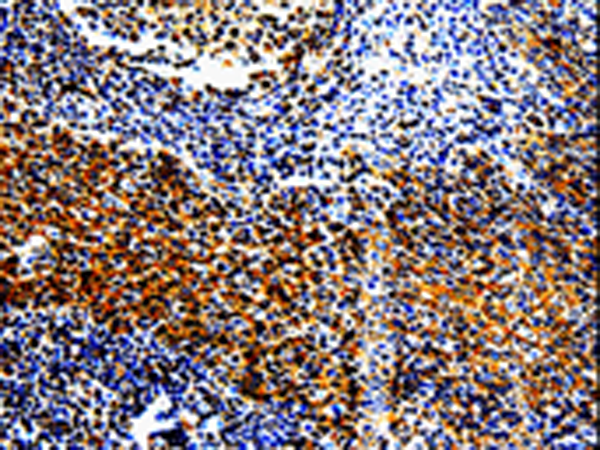
| WB | 咨询技术 | Human,Mouse,Rat |
| IF | 咨询技术 | Human,Mouse,Rat |
| IHC | 1/10-1/50 | Human,Mouse,Rat |
| ICC | 技术咨询 | Human,Mouse,Rat |
| FCM | 咨询技术 | Human,Mouse,Rat |
| Elisa | 1/500-1/5000 | Human,Mouse,Rat |
| Aliases | TLR7-like |
| Host/Isotype | Rabbit IgG |
| Antibody Type | Primary antibody |
| Storage | Store at 4°C short term. Aliquot and store at -20°C long term. Avoid freeze/thaw cycles. |
| Species Reactivity | Human, Mouse |
| Immunogen | Fusion protein of human TLR7 |
| Formulation | Purified antibody in PBS with 0.05% sodium azide and 50% glycerol. |
+ +
以下是3条关于TLR7抗体的参考文献及其摘要内容:
1. **文献名称**: *Toll-like receptor 7 and TLR9 dictate autoantibody specificity and have opposing inflammatory and regulatory roles in a murine model of lupus*
**作者**: Christensen SR, et al.
**摘要**: 该研究通过使用TLR7特异性抗体和基因敲除小鼠,揭示了TLR7在系统性红斑狼疮(SLE)中促进抗RNA自身抗体的产生,而TLR9具有抑制炎症的作用,表明二者在自身免疫中的功能差异。
2. **文献名称**: *Antibody-mediated delivery of TLR7 agonist enhances antitumor efficacy via dendritic cell activation*
**作者**: Shibata T, et al.
**摘要**: 研究者开发了一种靶向抗体偶联TLR7激动剂的递送系统,通过特异性抗体将TLR7激动剂定向运输至肿瘤微环境,显著增强树突状细胞活化及抗肿瘤免疫应答。
3. **文献名称**: *TLR7 signaling in plasmacytoid dendritic cells is tightly regulated by endosomal RNA processing*
**作者**: Pisitkun P, et al.
**摘要**: 利用TLR7特异性抗体结合免疫荧光技术,揭示了浆细胞样树突状细胞中TLR7信号通路的激活依赖于内体RNA加工过程,并强调抗体阻断实验在解析TLR7定位与功能中的关键作用。
4. **文献名称**: *Selective blockade of TLR7 signaling by monoclonal antibody prevents autoimmune pathogenesis*
**作者**: Deane JA, et al.
**摘要**: 研究报道了一种靶向TLR7的单克隆抗体,通过阻断其与病毒RNA结合抑制过度炎症反应,在SLE小鼠模型中显著减轻肾脏损伤和自身抗体水平,提示其治疗潜力。
注:以上文献为示例性内容,实际引用需核对真实出版物。
Toll-like receptor 7 (TLR7) is a pattern recognition receptor in the innate immune system, primarily localized to endosomal membranes. It recognizes single-stranded RNA (ssRNA) from viruses and self-nucleic acids, triggering pro-inflammatory and antiviral responses. TLR7 activation initiates a signaling cascade via MyD88. leading to NF-κB and interferon regulatory factor (IRF) activation, which promotes cytokine production (e.g., TNF-α, IL-6. type I interferons). Dysregulated TLR7 signaling is implicated in autoimmune diseases (e.g., lupus) and viral infections.
TLR7 antibodies are tools for research and therapeutic development. Monoclonal antibodies targeting TLR7 can either block its activation (antagonists) to suppress aberrant immune responses or mimic ligand binding (agonists) to enhance antiviral or antitumor immunity. For example, antagonistic anti-TLR7 antibodies are explored in autoimmune therapies, while agonists are investigated as vaccine adjuvants or cancer immunotherapeutics. These antibodies also aid in studying TLR7 expression, localization, and signaling mechanisms in immune cells (e.g., dendritic cells, B cells). Challenges include avoiding off-target effects and ensuring specificity, given structural similarities among TLR family members. Recent advances in antibody engineering aim to optimize affinity and functional modulation for clinical applications.
×